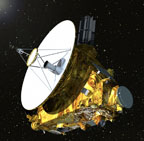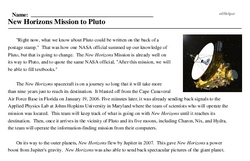New Horizons Mission to Pluto
"Right now, what we know about Pluto could be written on the back of a postage stamp." That was how one NASA official summed up our knowledge of Pluto, but that is going to change. The New Horizons Mission is already well on its way to Pluto, and to quote the same NASA official, "After this mission, we will be able to fill textbooks."
The New Horizons spacecraft is on a journey so long that it will take more than nine years just to reach its destination. It blasted off from the Cape Canaveral Air Force Base in Florida on January 19, 2006. Five minutes later, it was already sending back signals to the Applied Physics Lab at Johns Hopkins University in Maryland where the team of scientists who will operate the mission was located. This team will keep track of what is going on with New Horizons until it reaches its destination. Then, once it arrives in the vicinity of Pluto and its five moons, including Charon, Nix, and Hydra, the team will operate the information-finding mission from their computers.
On its way to the outer planets, New Horizons flew by Jupiter in 2007. This gave New Horizons a power boost from Jupiter's gravity. New Horizons was also able to send back spectacular pictures of the giant planet.
After Jupiter, New Horizons' next destination was Pluto and its moons. Pluto was still eight years away. So, to conserve its strength, New Horizons went into hibernation. Many of its instruments shut down, to be awakened only once per year for checkups until 2015.
One thing the scientists do not need to worry about is fuel for the long trip. Once it was on its way, New Horizons needed only about as much power as two ordinary light bulbs.




